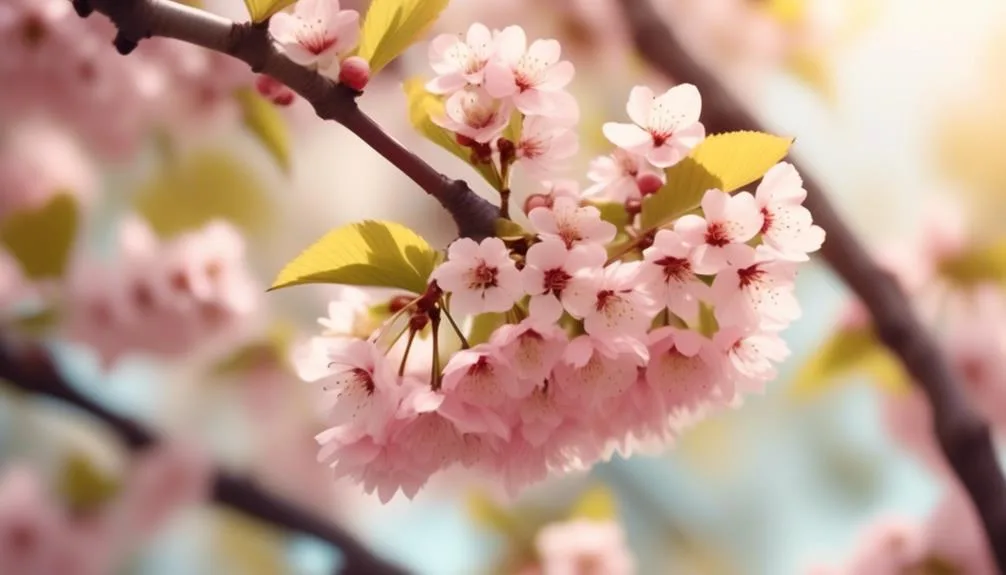Identifying different cherry tree varieties may seem overwhelming with so many types available. However, by learning to recognize differences in flower characteristics, leaf shapes, and sizes, you can become skilled at telling them apart.
Understanding these key features will help you accurately distinguish between cherry tree species. Let's explore the world of cherry trees and learn the secrets to identifying one variety from another.
Flower Characteristics
When examining cherry tree varieties, it's essential to pay close attention to the flower characteristics, as they're key indicators of the specific variety and can greatly enhance your appreciation of these beautiful trees.
Cherry tree flowers come in different colors, ranging from pure white to deep pink, and can be single or double blossoms. Observing these characteristics can help you identify the variety and understand its pollination requirements.
Some cherry tree varieties are self-pollinating, while others require a different variety for cross-pollination. Additionally, understanding the flower characteristics can also guide you in pruning techniques. Proper pruning not only maintains the tree's shape and health but also encourages abundant flower production, leading to a more bountiful harvest of cherries.
Leaf Shape and Size
Take note of the varying shapes and sizes of the leaves as you explore different cherry tree varieties in your garden. Each leaf tells a unique story about the tree, providing important clues for identification. Here's what to look for:
- Leaf color: Observe the color of the leaves, which can range from vibrant green to a deep, rich hue, and may even change with the tree's age.
- Leaf texture: Run your fingers over the surface of the leaves to feel their texture. Some may be smooth and glossy, while others could have a slightly rough or fuzzy texture.
- Tree age: Note how the size of the leaves relates to the age of the tree. Young cherry trees typically have smaller leaves, while mature trees often have larger, more developed ones.
- Environmental factors: Consider how environmental factors such as sunlight, water, and soil composition may influence the shape and size of the leaves.
Fruit Appearance
As you continue your exploration of cherry tree varieties, pay close attention to the distinctive appearance of their fruits, as it offers valuable insight for identification.
Cherry tree fruit size varies across different varieties, ranging from small, pea-sized fruits to larger cherries that are closer to the size of a small plum.
Additionally, cherry tree fruit color is an essential characteristic to observe. The color of the fruit can range from bright red to dark maroon, or even yellow when ripe, depending on the specific variety. Some varieties may also exhibit a two-tone color, with a darker hue on one side and a lighter shade on the other.
Bark and Trunk Features
Inspect the bark and trunk of cherry trees to discern distinct features that aid in their identification.
- Branch and twig patterns: Look for unique patterns in the way branches and twigs grow. Some cherry tree varieties have a more angular and symmetrical branching pattern, while others may have a more irregular and sprawling appearance.
- Color and texture variations: Note the color and texture of the bark. Some cherry trees exhibit smooth, shiny bark with a reddish-brown hue, while others may have rough, dark bark with prominent horizontal lenticels.
- Trunk size and shape: Observe the size and shape of the trunk. Some cherry tree varieties have slender trunks with a graceful, upright growth habit, while others have stout trunks with a more spreading growth form.
- Presence of lenticels: Look for the presence and arrangement of lenticels on the bark, as these can vary in color, size, and distribution, aiding in identification.
Growth Habit and Size
Examining the growth habit and size of cherry trees provides valuable clues for identifying different varieties, allowing you to appreciate their distinct characteristics and make informed decisions for cultivation.
Cherry trees generally fall into two categories: sweet cherries, which are larger and heart-shaped, and sour cherries, which are smaller and rounder.
The growth habit varies from upright to spreading, and the size of the tree depends on the rootstock, with dwarf varieties reaching 8-10 feet and standard trees growing up to 18-20 feet.
Understanding the growth habit and size is crucial for selecting the right location in your garden and implementing proper pruning techniques.
Additionally, cherry trees thrive in well-draining soil with good fertility and a slightly acidic to neutral pH, making soil requirements an essential consideration for successful cultivation.
Conclusion
With these tools, you can confidently distinguish between different cherry tree varieties by observing:
- Flower characteristics
- Leaf shape
- Fruit appearance
- Bark and trunk features
- Growth habits
Happy cherry tree spotting!
Mark Hoffman is a dedicated arborist and tree care specialist with over a decade of experience. His love for trees began when he visited Yosemite National Park as a teenager and was awestruck by the giant sequoias. Mark pursued his passion by studying forestry at Michigan Technological University, where he earned a Bachelor of Science degree.
Since then, he has worked tirelessly in the field of arboriculture, helping to preserve and protect trees in his community. His expertise and dedication have made him a respected leader in the industry and a valuable resource for anyone seeking advice on tree care.
